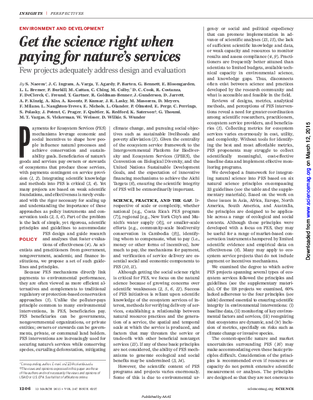Getting the science right when paying for nature's services

Author(s): Shahid Naeem, J.Carter Ingram, Alexandra Varga, Tundi Agardy, P. Barten, G. Bennett, E. Bloomgarden, L. Bremer, Peter Burkill, Megan Cattau, C. Ching, Michael Colby (USAID), D.C. Cook, Robert Costanza, Fabrice DeClerck, C. Freund, Todd Gartner, R. Goldman-Benner, J. Gunderson, D. Jarrett, A.P. Kinzig, Agnes Kiss, Ann Koontz, P. Kumar, J.R Laskey, Michel Masozera, D. Meyers, F. Milano, Lisa Naughton-Treves, E. Nichols, Lydia Olander, Paige Olmsted, E. Perge, Charles Perrings, Steven Polasky, Jeffrey Potent, C. Prager, F. Quétier, Kent Redford, Kathryn Saterson (US EPA), Gabriel Thoumi, M.T. Vargas, S. Vickerman, Wolfgang Weisser, David Wilkie, Sven Wunder
Publication Date: 2015
DOWNLOAD FILEPayments for Ecosystem Services (PES) mechanisms leverage economic and social incentives to shape how people influence natural processes and achieve conservation and sustainability goals. Beneficiaries of nature’s goods and services pay owners or stewards of ecosystems that produce those services, with payments contingent on service provision. Integrating scientific knowledge and methods into PES is critical. Yet many projects are based on weak scientific foundations, and effectiveness is rarely evaluated with the rigor necessary for scaling up and understanding the importance of these approaches as policy instruments and conservation tools. Part of the problem is the lack of simple yet rigorous scientific principles and guidelines to accommodate PES design and guide research and analyses that foster evaluations of effectiveness. As scientists and practitioners from government, non-government, academic, and finance institutions, with PES experience spanning six continents, we propose a set of such guidelines and principles.


